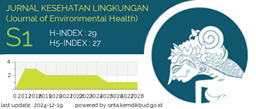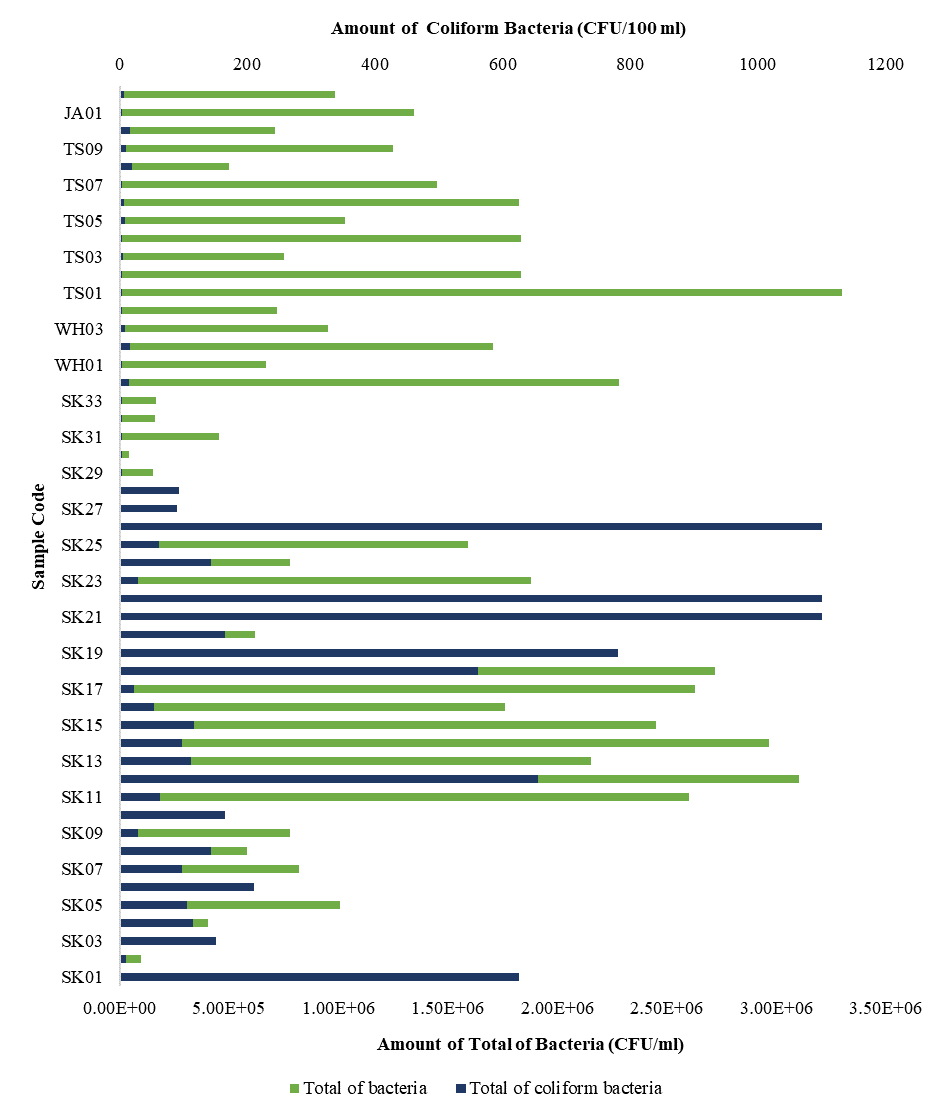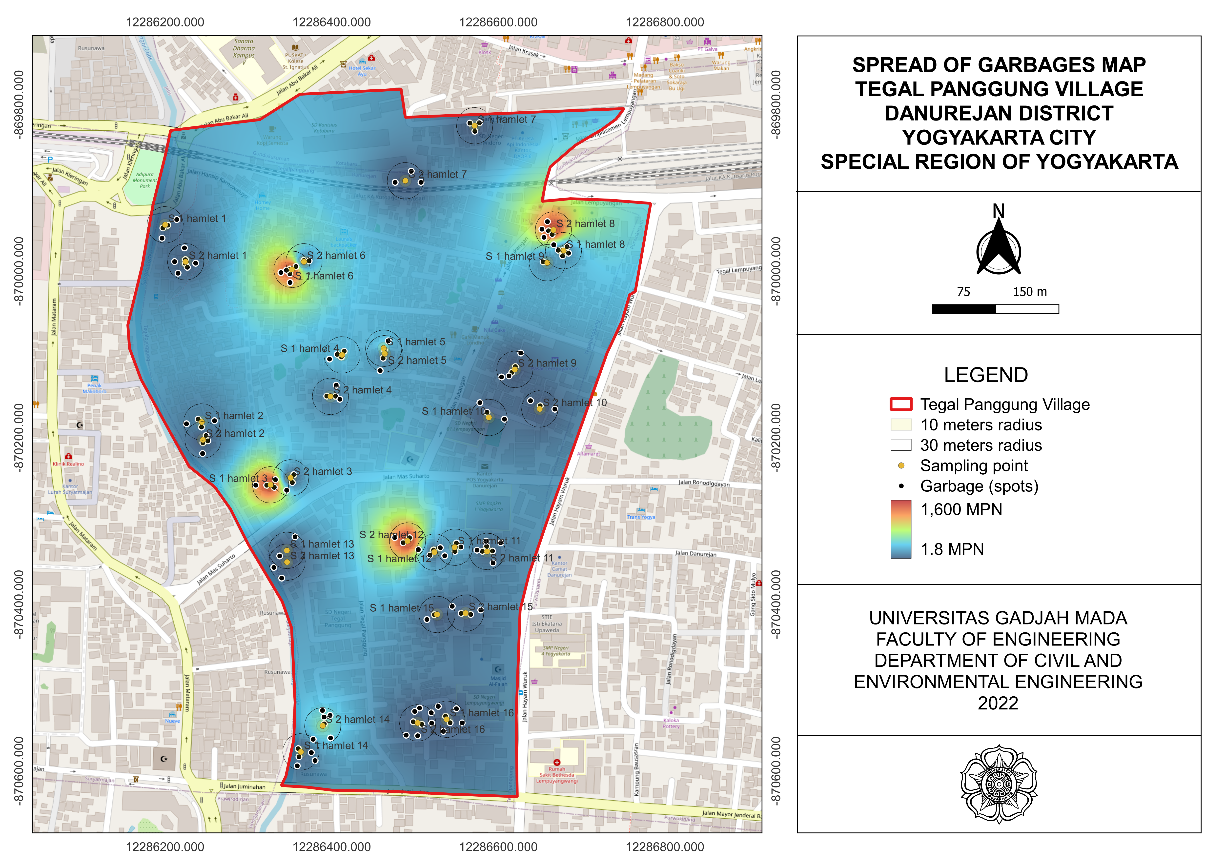Water Quality Status of Way Batanghari River, Metro City, Lampung Province Based on Water Fit for Consumption Parameters

Introduction: The need of water fit for consumption will continue to be sustainable along with the increasing human population, so we need a source of clean water that suitable for consumption. Therefore, this study aims to determine the water quality status of the Way Batanghari river based on an analysis of the feasibility of potable water. Methods: This research used survey method and water sampling in the Way Batanghari tributary, Metro City, Lampung using the consecutive sampling method. Results and Discussion: The physical parameters which include water color exceeds the 50 TCU and indicates the odor of ammonia. The chemical parameters which include COD were 63.5 mg/L (4th class) upstream, 59.3 mg/L (4th class) downstream. DO values upstream were 4.36 mg/L (1st class), 2.83 mg/L (3rd class) downstream. The phosporus value shows a number of 0.54 mg/L (2nd class). pH parameter which shows a value of 7.1 on the upstream, 6.6 on the downstream. Found species from class of Bacillariophyceae, Cyanophyceae as parameters of pollution. Conclusion: Based on Regulation of the Minister of Health, Republic of Indonesia Number 492 of 2010, this river has color and odor of water shows that indicates not meet the requirements for consumption.
Faisal M, Atmaja DM. Kualitas Air Pada Sumber Mata Air di Pura Taman Desa Sanggalangit Sebagai Sumber Air Minum Berbasis Metode Storet. Jurnal Pendidikan Geografi Undiksha. 2019 31;7(2):74–84. https://doi.org/10.23887/jjpg.v7i2.20691
Putri NP, Fuadah A. Manfaat Air Minum bagi Kesehatan Peserta Didik pada Tingkat MI/SD. Al- Adzka. 2020;10(1):33–42. https://doi.org/10.18592/aladzkapgmi.v10i1.3622
Rohmawati Y, Kustomo K. Analisis Kualitas Air pada Reservoir PDAM Kota Semarang Menggunakan Uji Parameter Fisika, Kimia, dan Mikrobiologi, serta Dikombinasikan dengan Analisis Kemometri. Walisongo Journal of Chemistry. 2020;3(2):100–107. https://doi.org/10.21580/wjc.v3i2.6603
Sara PS, Astono W, Hendrawan DI. Kajian Kualitas Air di Sungai Ciliwung dengan Parameter BOD dan COD. In Prosiding Seminar Nasional Cendekiawan. 2018;1(1):291–597. https://trijurnal.trisakti.ac.id/index.php/semnas/article/view/3478/2947
United Nations Development Programme. Sustainable Development Goals. New York: United Nations Development Programme; 2022. https://www.undp.org/sustainable-development-goals
Central Statistics Agent of of Metro City. Metro Municipality in Figures. Metro: Central Statistics Agent of of Metro City; 2022. https://metrokota.bps.go.id/publication/2022/02/25/13d3d0191c257e0855e63579/kota-metro-dalam-angka-2022.html/
Nufutomo TK. Perubahan Iklim Sebagai Ancaman Ketahanan Kualitas Air pada Daerah Aliran Sungai : Literatur Review. Jurnal Reka Lingkungan. 2022;10(3):188–200. https://ejurnal.itenas.ac.id/index.php/lingkungan/article/view/5963
Harlina H. Limnologi : Kajian Menyeluruh Mengenai Perairan Darat. Makassar: Gunawan Lestari; 2020.
Riyandini VL. Pengaruh Aktivitas Masyarakat Terhadap Kualiatas Air Sungai Batang Tapakis Kabupaten Padang Pariaman. Jurnal Sains dan Teknologi Keilmuan dan Aplikasi Teknologi Industri. 2020;20(2):203–209. http://dx.doi.org/10.36275/stsp.v20i2.297
Aufar DVG. Analisis Kualitas Air Sungai pada Aliran Sungai Kali Surabaya. Jurnal Swara Bhumi. 2019;1(1):1–6. https://ejournal.unesa.ac.id/index.php/swara-bhumi/article/view/31610
World Health Organization. Guidelines for Drinking-Water Quality: Fourth Edition Incorporating the First and Second Addenda. https://www.who.int/publications-detail-redirect/9789240045064
Ministry of Health of Republic Indonesia. Regulation of Ministry of Health of Republic Indonesia No. 492/MENKES/2010 about Quality Requirements of Drinking Water. Jakarta: Ministry of Health Republic of Indonesia; 2010. https://stunting.go.id/kemenkes-permenkes-no-492-tahun-2010-tentang-persyaratan-kualitas-air-minum/
Ministry of Health of Republic Indonesia. Regulation of Ministry of Health of Republic Indonesia 32 of 2017 about Environmental Health Quality Standards and Water Health Requirements for Hygiene, Sanitation, Swimming Pools, and Public Baths. Jakarta: Ministry of Health Republic of Indonesia. https://peraturan.bpk.go.id/Home/Details/112092/permenkes-no-32-tahun-2017
Hamonangan MC, Yuniarto A. Kajian Penyisihan Amonia dalam Pengolahan Air Minum Konvensional. Jurnal Teknik ITS. 2022;11(2):35–42. http://dx.doi.org/10.12962/j23373539.v11i2.85611
Wiyantoko B, Kurniawati P, Purbaningtias TE. Pengujian Nitrogen Total, Kandungan Air dan Cemaran Logam Timbal pada Pupuk Anorganik NPK Padat. Jurnal Sains dan Teknologi. 2017;6(1):51–60. https://doi.org/10.23887/jstundiksha.v6i1.9439
Hamuna B, Tanjung RHR, Suwito S, Maury HK. Konsentrasi Amoniak, Nitrat dan Fosfat di Perairan Distrik Depapre, Kabupaten Jayapura. EnviroScienteae. 2018;14(1):8–15. http://dx.doi.org/10.20527/es.v14i1.4887
Andika B, Wahyuningsih P, Fajri R. Penentuan Nilai BOD dan COD sebagai Parameter Pencemaran Air dan Baku Mutu Air Limbah di Pusat Penelitian Kelapa Sawit (PPKS) Medan. QUIMICA. 2020;2(1):14–22. https://ejurnalunsam.id/index.php/JQ/article/view/2617
Setyaningrum D, Anisa Z, Rasydta H. Pengujian Kadar Chemical Oxygen Demand (COD) pada Air Limbah Tinggi Kalsium Klorida Menggunakan Metode Refluks Terbuka. Formosa: Jurnal of Science and Technology. 2022;1(4):353–362. https://doi.org/10.55927/fjst.v1i4.1050
Aurilia MF, Santoso DH, Sungkowo A. Analisis Karakteristik dan Kualitas Mata Air di Desa Redin, Kecamatan Gebang, Kabupaten Purworejo. Jurnal Ilmiah Lingkungan Kebumian. 2021;3(2):1–12. http://jurnal.upnyk.ac.id/index.php/kebumian/article/view/JILK4302-12357-1
Harahap MR, Amanda LD, Matondang AH. Analisis Kadar COD (Chemical Oxygen Demand) dan TSS (Total Suspended Solid) Pada Limbah Cair dengan Menggunakan Spektrofotometer UV-VIS. Amina. 2020;2(2):79-83. https://journal.ar-raniry.ac.id/index.php/amina/article/download/772/791
Ramayanti D, Amna U. Analisis Parameter COD (Chemical Oxygen Demand) dan pH (potential Hydrogen) Limbah Cair di PT. Pupuk Iskandar Muda (PT. PIM) Lhokseumawe. QUIMICA. 2019;1(1):16–21. https://ejurnalunsam.id/index.php/JQ/article/view/1689
Putri NM, Hardiansyah F. Efektivitas Penerapan Teknologi pada IPAL Komunal Ditinjau dari Parameter BOD, COD, dan TSS. Jurnal Teknik Pengairan. 2022:30;13(2):183–194. https://jurnalpengairan.ub.ac.id/index.php/jtp/article/view/628
Tardepa O, Clourisa Amaris Susanto N. Analisis kandungan Chemical Oxygen Demand (COD) dan Biochemical Oxygen Demand (BOD) pada Air Sungai Danau Teluk Kelurahan Olak Kemang kota Jambi. Thesis. Jambi: Universitas Jambi; 2021. https://repository.unja.ac.id/24098/
Government of Republic Indonesia. Government Regulation No 2 of 2021 about Implementation of Environmental Protection and Management. Jakarta: Government of Republic Indonesia; 2021. https://peraturan.bpk.go.id/Home/Details/161852/pp-no-22-tahun-2021
Alfatihah A, Latuconsina H, Prasetyo HD. Analisis Kualitas Air Berdasarkan Paremeter Fisika dan Kimia di Perairan Sungai Patrean Kabupaten Sumenep. AQUACOASTMARINE. 2022;1(2):76–84. https://doi.org/10.32734/jafs.v1i2.9174
Yuniarti Y, Biyatmoko D. Analisis Kualitas Air dengan Penentuan Status Mutu Air Sungai Jaing Kabupaten Tabalong. Jukung Jurnal Teknik Lingkungan. 2019;5(2):52-69. http://dx.doi.org/10.20527/jukung.v5i2.7319
Handoco E. Studi Analisis Kualitas Air Sungai Bah Biak Kota Pematangsiantar. TRITON. 2021;17(2):117–124. https://doi.org/10.30598/TRITONvol17issue2page117-124
Madyawan D, Hendrawan IG, Suteja Y. Pemodelan Oksigen Terlarut (Dissolved Oxygen/DO) di Perairan Teluk Benoa. Journal of Marine and Aquatic Science. 2020;6(2):270-280. https://doi.org/10.24843/jmas.2020.v06.i02.p15
Christiana R, Anggraini IM, Syahwanti H. Analisis Kualitas Air dan Status Mutu Serta Beban Pencemaran Sungai Mahap di Kabupaten Sekadau Kalimantan Barat. Jurnal Serambi Engineering. 2020;5(2):941-950. http://ojs.serambimekkah.ac.id/index.php/jse/article/view/1921
Kospa HSD, Rahmadi R. Pengaruh Perilaku Masyarakat terhadap Kualitas Air di Sungai Sekanak Kota Palembang. Jurnal Ilmu Lingkungan. 2019;17(2):212–221. https://doi.org/10.14710/jil.17.2.212-221
Zairinayati ZR, Shatriadi H. Biodegradasi Fosfat pada Limbah Laundry menggunakan Bakteri Consorsium Pelarut Fosfat. Jurnal Kesehatan Lingkungan Indonesia. 2019;18(1):57-61. https://doi.org/10.14710/jkli.18.1.57-61
Paputungan F, Pangemanan NPL, Tumbol RA, Undap SL, Tumembouw SS, Rantung SV. Kajian Kualitas Air untuk Menunjang Perikanan Budidaya Danau Moaat, Provinsi Sulawesi Utara. E-Journal Budidaya Perairan. 2021;10(2):134-143. https://doi.org/10.35800/bdp.10.2.2022.37130
Anggraini IM, Syahwanti H. Pemetaan Sebaran Kandungan Tingkat Keasamaan (pH) Air Sungai Mahap Kabupaten Sekadau. Jurnal Teknologi Infrastruktur. 2022;1(1):1-6. https://jurnal.upb.ac.id/index.php/ft/article/view/252
Djoharam V, Riani E, Yani M. Analisis Kualitas Air dan Daya Tampung Beban Pencemaran Sungai Pesanggrahan di Wilayah Provinsi DKI Jakarta. Journal of Natural Resources and Environmental Management. 2018;8(1):127–133. https://doi.org/10.29244/jpsl.8.1.127-133
Ramadani R, Samsunar S, Utami M. Analisis Suhu, Derajat KeasamaN (pH), Chemical Oxygen Demand (COD), dan Biologycal Oxygen Demand (BOD) Dalam Air Limbah Domestik di Dinas Lingkungan Hidup Sukoharjo. Indonesian Journal Chemistry Research. 2021;6(1):12–22. https://doi.org/10.20885/ijcr.vol6.iss1.art2
Agustina Y, Atina A. Analisis Kualitas Air Anak Sungai Sekanak Berdasarkan Parameter Fisika Tahun 2020. Jurnal Penelitian Fisika dan Terapannya. 2022;4(1):13–19. http://dx.doi.org/10.31851/jupiter.v4i1.7875
Sanjaya RE, Iriani R. Kualitas Air Sungai di Desa Tanipah (Gambut Pantai), Kalimantan Selatan. BIOLINK. 2018;5(1):1–10. https://doi.org/10.31289/biolink.v5i1.1583
Wiyarsih B, Endrawati H, Sedjati S. Komposisi dan Kelimpahan Fitoplankton di Laguna Segara Anakan, Cilacap. Buloma: Buletin Oseanografi Marina. 2019;8(1):1–8. https://doi.org/10.14710/buloma.v8i1.21974
Rasyid HA, Purnama D, Kusuma AB. Pemanfaatan Fitoplankton Sebagai Bioindikator Kualitas Air di Perairan Muara Sungai Hitam Kabupaten Bengkulu Tengah Provinsi Bengkulu. Jurnal Enggano. 2018;3(1):39–51. https://doi.org/10.31186/jenggano.3.1.39-51
Hadi YS, Japa L, Zulkifli L. Community Structure of Bacillariophyceae in the Water of Klui Beach, North Lombok. Jurnal Biologi Tropis. 2022;22(2):557–564. https://doi.org/10.29303/jbt.v22i2.3398
Rosanti L, Harahap A. Keberadaan Plankton sebagai Indikator Pencemaran. BIOEDUSAINS. 2022;5(1):182–188. https://doi.org/10.31539/bioedusains.v5i1.3529
Fadilah K, Jawwad MAS, Nisa' QZ. Struktur Komunitas Fitoplankton sebagai Indikator Kualitas Air di Kali Mas Kota Surabaya. Bioscientist. 2022;10(2):799-808. https://doi.org/10.33394/bioscientist.v10i2.6077
Fastner J, Teikari J, Hoffmann A, Köhler A, Hoppe S, Dittmann E, et al. Cyanotoxins Associated with Macrophytes in Berlin (Germany) Water Bodies – Occurrence and Risk Assessment. Science of the Total Environment. 2023;858(1):159433. https://doi.org/10.1016/j.scitotenv.2022.159433
Hairunnadawiah H, Khairuddin K, Zulkifli L. Microalgae Diversity as a Bioindicator of Water Quality in Batujai Dam, Central Lombok. Jurnal Biologi Tropis. 2022;22(1):315–322. https://doi.org/10.29303/jbt.v22i1.3084
Wicaksono AZ. Kualitas Situ di Kota Tangerang Selatan Berdasarkan Kimia Fisik dan Fitoplankton Sebagai Bioindikator. Thesis. Jakarta: Universitas Islam Negeri Syarif Hidayatullah; 2022. https://repository.uinjkt.ac.id/

This work is licensed under a Creative Commons Attribution-NonCommercial-ShareAlike 4.0 International License.
1. Copyright of all journal manuscripts is held by the Jurnal Kesehatan Lingkungan.2. Formal legal provisions to access digital articles of electronic journal are subject to the provision of the Creative Commons Attribution-ShareAlike license (CC BY-NC-SA), which means that Jurnal Kesehatan Lingkungan is rightful to keep, transfer media/format, manage in the form of databases, maintain, and publish articles.
3. Published manuscripts both printed and electronic are open access for educational, research, and library purposes. Additionally, the editorial board is not responsible for any violations of copyright law.
JKESLING by UNAIR is licensed under a Creative Commons Attribution-ShareAlike 4.0 International License.







































